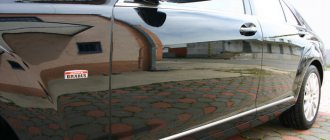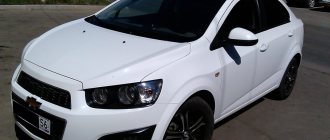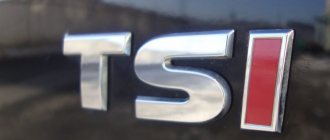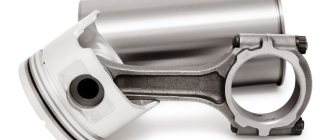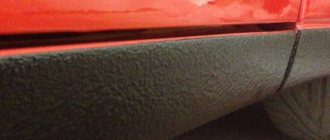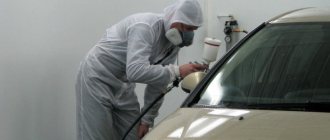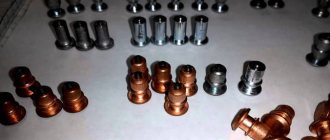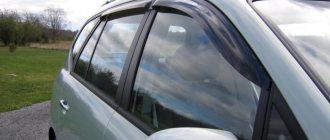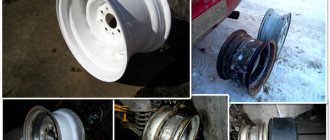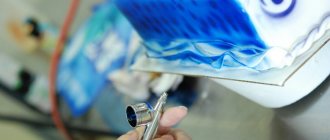In this article we will understand what a ceramic coating is, its characteristics, application method, pros and cons.
To protect body paint, the most popular coating has always been wax. This is a good barrier against aggressive environmental influences, but requires periodic updating.
A new, more wear-resistant and durable body surface protection product has appeared on the market. This is a ceramic coating. This method of protecting paintwork has become a massive trend in the detailing industry. It can be a good alternative to protective wax. The ceramic coating creates a strong bond with the body paint, will not be erased or destroyed during washing and will not require frequent renewal.
You can compare the duration of action of popular protective compounds:
- The wax lasts 6-8 weeks.
- Sealant (synthetic paint sealant) lasts 5-6 months.
- A good ceramic coating can last for 2 years or more, depending on the quality of application, further use and care.
Let's take a closer look at what a ceramic coating can provide and what you shouldn't expect from it.
Content:
- What are the benefits of ceramic coating?
- What can't ceramic coating do?
- What is the main disadvantage of ceramic coating?
- What does ceramic coating consist of?
- How hard does ceramic coating actually have?
- Coating a car with ceramics
What are the benefits of ceramic coating?
Here are the benefits of ceramic coating:
- Protection against ultraviolet radiation and oxidation. If the car is often exposed to the scorching sun, the paint begins to fade and fade. The ceramic protective layer prevents this destructive process.
- Protection from chemicals. Oils, gasoline, and acidic precipitation do not affect the ceramic protective layer.
- Easy to wash the body. One of the most significant properties of a ceramic coating is its hydrophobicity. That is, it has water-repellent properties. Water simply rolls off the surface of the body. Contaminants also do not stay on the surface for a long time, or do not stick too strongly. The nanostructure of the ceramic layer ensures increased evenness and smoothness of the surface. Thus, the contaminants have nothing to cling to the surface and it simply slides off it. Surface energy is reduced.
- Improved shine. The paintwork acquires improved reflectivity and deep gloss.
- Resistant to minor scratches. The surface of the ceramic layer is harder than the original paintwork.
- Constant long-term protection (up to 5 years).
- Improves anti-corrosion protection. The ceramic composition penetrates into all pores and cracks of the paint and seals them. Repeated tests of the action of destructive salts were carried out and the ceramic coating performed well.
- Resistant to high temperatures (up to +780 degrees).
- The ceramic layer protects against bird droppings and tree resin. Such contaminants are much easier to remove from the body.
- Provides protection against spray painting on the body (anti-graffiti). The paint is easily removed without consequences.
- Gives an anti-icing effect.
- Almost all surfaces of the car can be treated.
A short theoretical excursion
Car paintwork
What is this innovative coating that can instantly transform your car and even protect its surface from damage? Auto repair shops use various compositions, most of which are based on silicic acid salts. You can try to apply some of them yourself, but the result is unlikely to satisfy you. Other products for ceramic coating, in general, can only be used in a specially equipped workshop and with the appropriate professional equipment. But the first so-called liquid glass, which is also used to cover the body, was invented at the beginning of the 19th century. Of course, its composition has changed significantly since then, but the origins of modern nanocoating go back to 1818.
Coating process
So what is in the nanoceramic coating for a car? The majority (more than 50%) is occupied by silicone liquid, characterized by increased resistance to oxidation. In second place in the composition of auto ceramics is quartz. It is this component that is the very substance due to which the body coating becomes hard and durable. The polymer film on the surface of the car is formed due to the alkoxysilanes contained in it. The remainder of the ceramic coating is titanium dioxide, aluminum oxide and surfactants. All these components are responsible for the thermal protection of the coating, its ability to repel dust and dirt, as well as its strength and elasticity. Of course, depending on the brand, the composition of the ceramic coating may vary slightly, but silicon will always be present in them.
What can't ceramic coating do?
- Ceramic coating does not mask paint imperfections. If you apply it to a surface with scratches, they will be visible and cannot be removed, since under the layer of “ceramics” the paint cannot be changed. For this reason, the protective composition must be applied to a new or abrasively polished surface.
- A ceramic coating will not be able to completely eliminate scratches and chips from the car body during operation. Scratch resistance is often exaggerated. It will protect against minor scratches, but will not protect against more serious scratches and chips caused by external force. Improper washing may still scratch the surface. It cannot be considered a replacement for the more reliable protection against chipping that a transparent protective film provides. When hit, a stone bounces off and can leave a mark on the film, but not on the body.
- It is not able to completely eliminate the formation of marks from dried water. Thus, water usually contains some amount of salts and impurities. After it evaporates, all salts and contaminants remain on the body in the form of visible traces. Most of the water actually slips and rolls off the car body, but still a certain percentage of the water remains and, as it evaporates, leaves marks.
- Regular washing of a car coated with “ceramics” cannot be ruled out. The car will still get dirty, but the dirt won't stick to the surface as much. Washing becomes easier and further waxing of the body is not required, but still must be done regularly.
- An important feature of ceramic protection is the importance of surface preparation before application. The further service life of the protection will depend on this. The preparation and application procedure will be discussed in this article below.
Body protective coatings
Ceramic car coating, pros and cons
There is nothing eternal, but you still want to keep the paint on the body fresh longer. Therefore, new polishes and films continue to appear, designed to protect the body from chips and scratches.
In general, it’s worth figuring out what we want from a protective body coating:
- Easy to apply. If the composition is applied for four days, and then takes another week to become operational, then its relevance is in great doubt.
- Strength. Of course we want a durable protective coating, but how much? It cannot be infinitely durable, because scratches and chips appear even on glass. Eventually the glass breaks. A strength slightly higher than that of the finishing varnish will be sufficient. By the way, strength is measured on the Mohs scale in units of N.
- Elasticity. Without elasticity, the coating will simply crack, since the metal on the body is constantly “playing”.
- Preservation of paint color saturation. At a minimum, preservation, since many dealers claim that the compositions can magically increase the saturation of paint. This doesn't happen.
These are not all of our requirements for a protective coating, but let’s dwell on them for now. For example, consider the so-called ceramic compositions for protecting paintwork, since they have become somewhat popular.
What is the main disadvantage of ceramic coating?
This is not a minus, but a feature. Since the ceramic surface can still be scratched, sooner or later scratches may appear on it for various reasons. Not as much as on an unprotected or waxed surface, but there will be some. These scratches cannot be removed by polishing, as with regular varnish. The only way to remove scratches is to remove the old ceramic layer and apply a new one. Considering its cost, this is not easy to do. This requires abrasive surface treatment, which, together with the ceramic coating, will also remove a small amount of the original paintwork. For example, if a car has been waxed, it can be renewed at any time. This is easy to do in certain places that require it. This cannot be done with the ceramic layer, because it is a permanent, long-term layer that has a strong bond with the paintwork.
Scratches on the ceramic coating after improper body washes.
Only careful operation and care of the protective layer depends on you. Every scratch that appears during this period will remain on the car until the moment when you decide to completely remove the “ceramics” and apply a new one. Manufacturers solve this problem with an additional layer of polish, which requires periodic updating. So people who believed in the miraculous power of “ceramics” and decided to “apply and forget” may be disappointed. This protection also requires some care.
Professional detailers and restorers do not recommend applying a ceramic protective layer to expensive classic cars, so as not to affect their original paint, but apply wax.
How does ceramics protect a car?
To answer this question, let's think about what harms the car, and in particular the body.
First place - wash
I proudly take first place with car washes; they climbed to the pedestal thanks to the lack of technology and education. Well, understand, the profession of a washer is akin to a loader; today I work, I don’t work tomorrow, so the employer does not want to spend money on staff training, hence the lack of knowledge of the technology and lack of understanding of the process. Administrators control only one parameter: “clean - dirty”. Clean is good, dirty is bad. Methods to achieve “clean” are not considered, but in them lies the death of the car.
There is a simple truth - the hard scratches the softer. Dust, sand, reagents, salt, snow, ice, brush, scraper - all this is harder than the varnish on a car, and all this will inevitably scratch it. What to do? There are two options - the first is not to wipe the car after washing, the second is to go only to a detailing wash, fortunately such ones have appeared. Two or three per city, but they exist.
How to check if they are good? It's simple. Wash - if a “cobweb” appears on the body (small scratches that are visible when light hits the body, visually look like circles-smudges), then its quality is not high enough, you will have to ask not to wipe it off. Why am I focusing on the “web”? Because as it accumulates, it turns the body from glossy to obscenely matte. We delicately say, “a used car,” but we think to ourselves, “already old.”
What's next? That's right - reagents and sand
Second place is theirs. Reagents are active substances that not only melt snow and ice, but also successfully eat into varnish, cause corrosion, and destroy rubber bands and chrome. A kind of road terrorists. Here ceramics are used throughout the weapon, it does not allow reagents to pass through, does not allow it to come into contact with the varnish and begin to destroy it. The same thing with the suspension, treated with a preservative it lasts twice as long.
As for sand and stones.
It all depends on the speed of movement. According to experience, ceramic protection reduces the likelihood of chipping by 60-70%, at speeds no higher than 130 km/h, after 200 km/h it stops working altogether. We call it the “speed tax” - if you want to drive fast, you have to paint the hood and bumper once a year. This is fine.
Third place - ultraviolet
There is a lot of sun in St. Petersburg and Moscow, but the car manages to burn out. Ceramics also protects against this impact, maintaining a rich, deep color.
Fourth - alkalis and acids
Namely, bird droppings, crushed insects, detergents at sinks - they are all aggressive, corroding poor varnish, leaving stains and streaks. There is little beauty. Nanoceramics were developed specifically to combat these consequences. True, not on cars, but on airplanes. There is a big problem in aviation - insects during takeoff and landing and the cleaning of aircraft from their remains. Ceramic coating made this task much easier.
Fifth - paint
No, this is not hooliganism, although it also happens that a car is spray-painted. You parked next to a bridge, and suddenly they started painting it, and a spray of paint blew onto the car. The case is frequent - Krestovsky Island knows. How to save a car? Naturally, this will not wash off in the car wash. It is necessary to clean with polishing clay and then correct the paintwork. The procedure is long and complicated. If you are lucky and your car has been treated with ceramics, you will get it washed at a thorough detailing wash.
Sixth place - driver
Sixth, drivers who are poorly oriented in space and determine dimensions by the characteristic sound. Of course, no one is safe from wear and scratches. But with a ceramic coating there is still a big chance to do without painting. Detailing centers will be able to remove the damaged ceramic layer and replace it with a new one. If the damage is not deep, in other words, the scratches have not reached the ground, then this method will save 6-7 thousand on painting and, more importantly, two days of time, and will also keep the car in its original paint. Beauty!
These are the main pests of the appearance of the car. In addition to vandalism, ceramics copes successfully with many of them.
Why is ceramic coating called nano coating?
The technology for producing nanoceramics was discovered back in 1980, after which the methods for producing nanoceramics were improved.
Enlarged structure of ceramics on the left and nanoceramics on the right.
Nano-materials are materials whose constituent particles have a size of no more than 100 nm. With this particle size, the material acquires completely different properties compared to conventional materials. Thus, the prefix “nano” refers specifically to the structure of the ceramic, and not to the thickness of the layer obtained during its application (as is often mentioned when describing the properties of nano-ceramics). In fact, the total thickness of several layers of “ceramics” is almost 100 times greater than the wax layer.
Nano-ceramics has unique properties that simple ceramics do not have. Conventional ceramics with a macrostructure are brittle, hard and easily destroyed upon impact. However, nano-ceramics has other properties, including super ductility and higher impact strength.
What does ceramic coating consist of?
Ceramic coatings from different manufacturers may have different compositions. There are many brands that do not have their own factories. They purchase semi-finished products from large manufacturers, then come up with various loud slogans, but do not advertise the exact composition of their products.
The ceramic coating formula includes solvents/thinners, different concentrations of SiO2 (or other base elements), as well as other components that affect its properties. The main component can be SiO2 (Silicon Dioxide), TiO2 (Titanium Dioxide) and SiC (Silicon Carbide). Good “ceramics” may not contain a binding polymer, which is the weak link. Thus, the protective layer is completely inert and wear-resistant.
SiO2 is the main component of sand. It has the best cost-effectiveness ratio when forming hydrophobic coatings, which is why it is most often used.
TiO2 provides better protection against ultraviolet rays, as well as high hardness.
SiC is very rare in nature, but is often used as a synthetic diamond in industry and has high hardness. Silicon carbide (SiC) is found in OptiCoat ceramic coatings. This is the only product on the market containing this component.
An important criterion for a high-quality protective composition is the presence of a high percentage of SiO2 or its substitutes. A good product should contain at least 50% SiO2.
Ceramic body protection
Ceramic body coating (CBC) is essentially the same liquid glass, but the composition itself is more complex and the proportion of its components is somewhat different. CPC is divided into two types - polymer (conventional) and based on nanotechnology; the ceramics contain silicon dioxide (SiO2), and the most important component is decamethylcyclopentasiloxane, more than 50 percent of it. There is also titanium oxide (up to three percent), it is this substance that provides thermal protection; in total, the composition usually contains 6 components. The prefix “nano” means that the particles of the substance are very small, but it is possible that liquid glass and ceramics are fundamentally not much different from each other, and different names are just a cunning move by marketers.
Ceramic protection is a thin layer of film applied to the surface of a paintwork coating (LPC), primarily intended to protect the surface of the body from external damage. Polymer ceramics are considered more durable than nanoceramics, although “nano” also has its own advantage - this coating gives the car a more attractive appearance.
How does a ceramic coating bond to paintwork?
In advertising, manufacturers often talk about the formation of a chemical bond between the “ceramics” and the paint coating after its application.
In varnish (which is a stable structure in itself, especially urethane varnish) there are no reagents that react to create a chemical bond with the nanoceramic structure. The only reason why the “ceramics” stays in place is due to the mechanical interconnection of the 2 structures. Simply put, we can say that due to the fact that nano-ceramics contains very small particles, they penetrate into all the irregularities and pores of the paint, and after the solvents evaporate, the ceramic layer holds very firmly and, one might say, becomes part of the paintwork. But this is not a chemical bond, at least not a covalent one, when the electrons of the substances being connected are combined. Varnish, for example, is applied to the base and adheres to the surface mechanically and does not create a chemical bond, and does not peel off.
Features of polishing nanoceramics
Of course, an expensive procedure cannot be reduced to removing small chips and renewing the protective layer. Therefore, already “installed” ceramic varnish requires as many as 12-15 processing steps. First of all, only a crystal clean machine will do the job, so, of course, wash it thoroughly first. Next, painstaking work is carried out, which includes several stages of polishing using pastes that include abrasives of different fractions. First, large chips and scratches are removed, and then you need to get rid of small defects and defects left by polishing discs. In this case, the room must have a certain humidity and temperature. The pastes themselves also work only on heated surfaces, so only a master can place the polishing machine at the correct angle and prevent overheating.
A step to the left is a step to the right, and you won’t get good coverage. Therefore, it is imperative to take into account the thickness of the original paint layer, the presence of plastic elements and alloy parts. They all heat up at different rates. And if the varnish softens, then all the work is in vain.
Then the second stage of processing begins, which includes repeated polishing with various abrasive pastes and the use of an eccentric machine with a soft disk. After this, pastes with smaller abrasive particles are used. But that's not all.
The third stage of processing begins. The eccentric machine comes into play again, but now a soft circle is installed on it. If on the first the strength of the paste was H8, on the second – F5, now composition M3 is required. With its help, the shortcomings of previous treatments are removed. After all this suffering, the master will definitely offer to cover the car with a protective layer (most likely liquid glass), explaining this by saying that polishing is polishing, but protection is needed. Having received consent, the specialists perform a bunch of other manipulations: they cover the body with Primer, again use the eccentric machine and “polish” the surface with microfiber manually. At the same time, the box in which the car is located is kept as clean as in a hospital ward.
As a result, you will have to pay for each manipulation. One paste treatment costs at least 600 rubles. In this case, each individual element of the car is paid for. Plus, it takes a master at least 3 hours to carefully polish the ceramic varnish. As a result, the work takes at least 33 hours (and this is without applying a protective layer). This means that a specialist spends 12 hours a day processing only one car, so that after three days he can present it to its rightful owner, and then begin applying liquid glass. Can such a service be cheap? Of course no. The “polishing work” alone will cost about 22,000 rubles, and there is also manual work and almost sanitary and hygienic control. Ultimately, polishing ceramic varnish will cost the same 50,000 rubles.
But maybe all this will be worth it and the car will be like a tank that doesn’t even care about flying cobblestones? Alas, no. The only positive effect of using such a coating is the creation of an additional dense layer that will not allow damage to reach the body of the car. And chips from stones will occur both with and without nanoceramics.
How hard does ceramic coating actually have?
When describing benefits, manufacturers often mention 9H as the highest point on the hardness scale.
Wolf Wilborn test kit for determining the hardness of coatings.
Sometimes, in discussions of the hardness of “ceramics,” it is specified that this value is determined by the Mohs test, which uses various minerals to test the hardness of a surface by scratching it with the minerals.
The test involves only 10 minerals from the softest (talc) to the hardest (diamond). So you might think that the hardness of 9H ceramic coating is close to diamond. In fact, the 9H value indicates hardness on the Wolf Wilborn hardness scale. A typical paint coating on this scale will have a value of approximately 3H-4H. This is a pencil hardness test. This test is common when determining the hardness of paintwork.
On the container below you can see the explanation “9H Pencil Hardness”, which translates as “9H pencil hardness”.
When testing, pencils of varying degrees of hardness are pressed and moved over the surface to be tested until the surface is scratched. To do this, a special block is used to hold the pencil at a certain angle (45 degrees). The movement is made in the direction where the pencil lead is directed. There is even an ISO 15184 standard that defines the correct procedure for testing the hardness of varnishes and paints with this test. This test is not exact, but gives a rough idea of the hardness of the coating.
On the Mohs scale, graphite (pencil lead) will have a hardness of about 1.5, but not 9. Manufacturers of the ceramic composition Ceramic Pro describe the advantages of their product in the ability to apply several layers, which increases hardness. So, according to the manufacturer himself, 4 layers will reach a value of 6 on the Mohs scale.
Wolf Wilborn test pencil hardness scale.
One way or another, the hardness of “ceramics” is far from the hardness of diamond and, based on practice, the ceramic coating is scratched, but not as easily as regular varnish.
Ceramic care
You can wash the body no earlier than 2-2.5 weeks after applying the ceramics. It is better to carry out the process using hardware, without rags. Otherwise, stains and spots may appear after the procedure. It is prohibited to use sharp objects to clean the surface - there is a risk of scratches.
It is recommended to wash the body after applying “liquid glass” after 2-2.5 weeks using a hardware method
After 12-15 months, the coating loses its shine and requires a new application. This reduces the cost. Most centers provide a 1-2 year warranty. As a rule, this figure shows the “life cycle” of the nanocoating. However, if the film is of poor quality, then the duration is reduced to 4-5 months.
